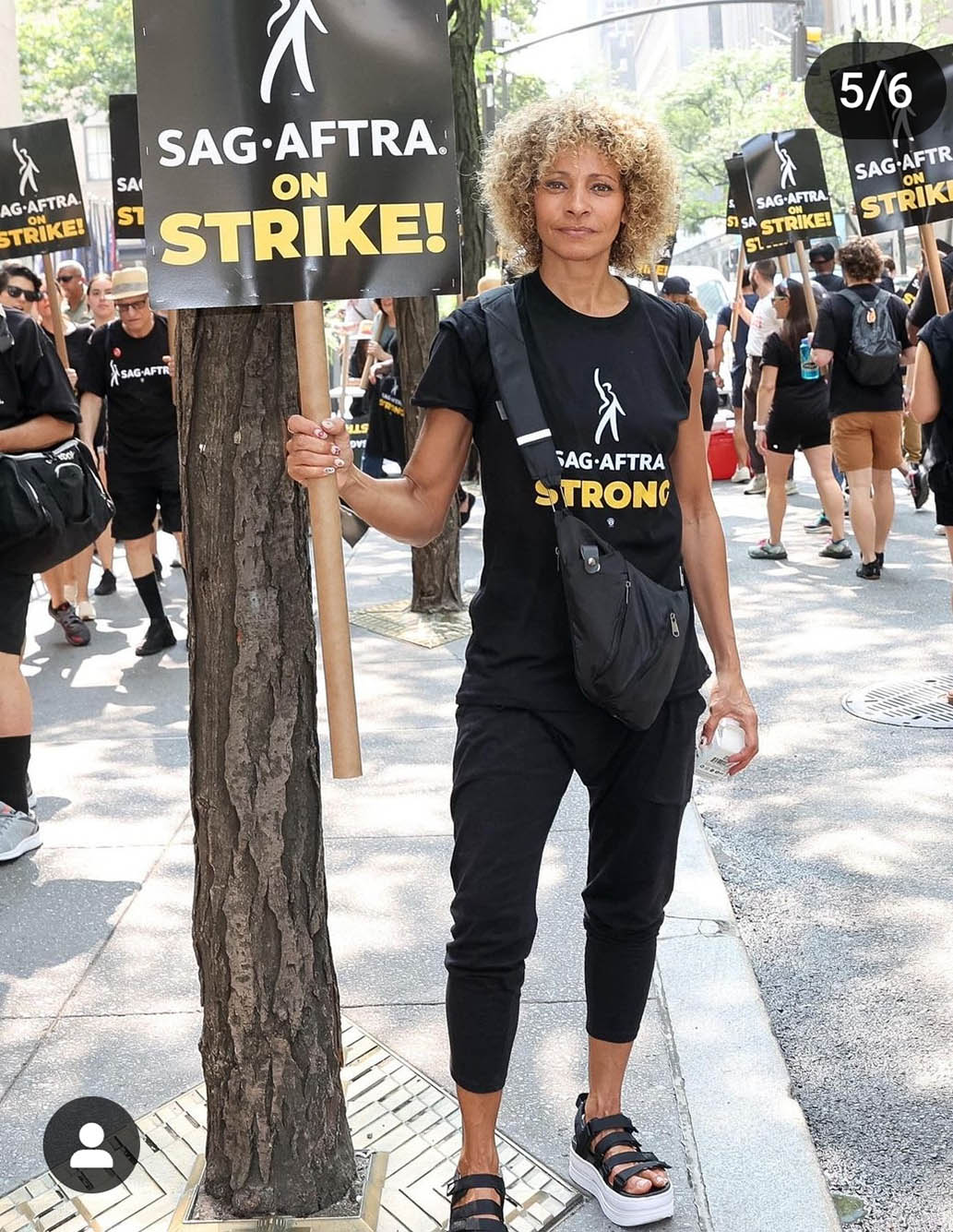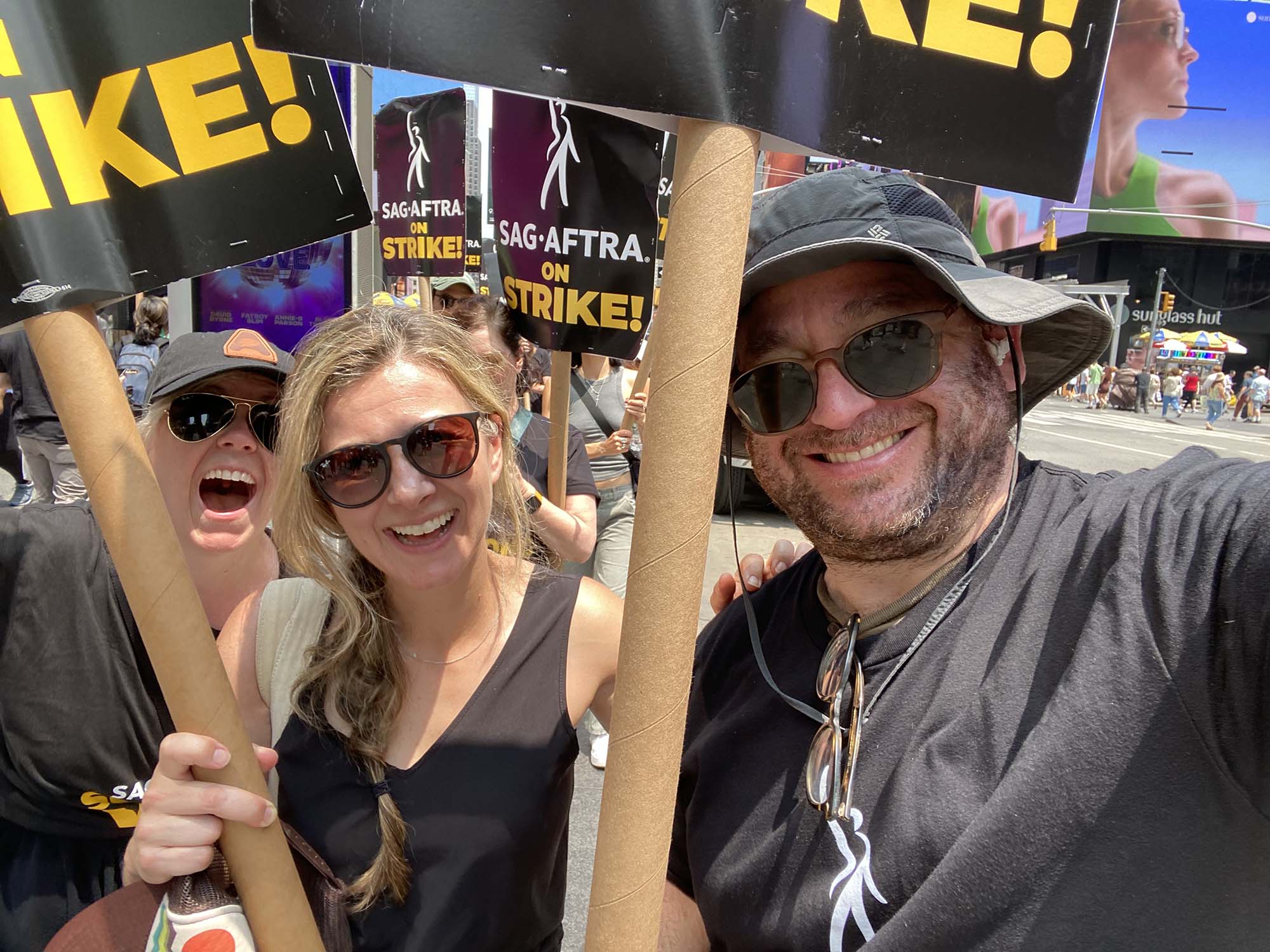BU Actors Celebrate Hollywood Strike Settlement and Return to Work
“I felt terrible for all the hundreds, if not thousands, of other hard-working people…who became unemployed”—CFA alum Dave Shalansky

SAG-AFTRA President Fran Drescher (center) with Duncan Crabtree-Ireland, national executive director and chief negotiator, and TV/Theatrical Negotiating Committee members at the SAG-AFTRA offices in Los Angeles on November 10. Photo by Richard Vogel via AP
BU Actors Celebrate Hollywood Strike Settlement and Return to Work
“I felt terrible for all the hundreds, if not thousands, of other hard-working people…who became unemployed”—CFA alum Dave Shalansky
“I so need a vacation,” says actor Michelle Hurd. It’s now a few days after the SAG/AFTRA strike against the Alliance of Motion Picture and Television Producers was settled, 118 days after its onset.
Technically, of course, she and fellow actors have not been working for four months. But Hurd (CFA’88) was plenty busy during that time as a member of the SAG/AFTRA (Screen Actors Guild–American Federation of Television and Radio Artists) negotiating committee and manning picket lines in both New York and Los Angeles.
Boston University has a number of alums who are actors working in Hollywood. BU Today spoke with several of them at the onset of the strike and two following its resolution, Hurd and Dave Shalansky (CFA’96). During the strike, there was unanimity in the anger and frustration, the belief in the cause, the necessity of the strike, and naturally, there was relief and joy when it was over. The victory is being called “a massive win” by members of the negotiating committee.
“I didn’t expect it to go this long,” Hurd says, “but I wasn’t surprised, because I saw how they treated us. I think it’s sad that they desperately didn’t want us to feel like we are collaborators in this beautiful, sacred art form of storytelling. That’s just so wrong. We realized these guys are beating [us] down, they don’t want to give up any bit of the pot.”
“I’ve been through several strikes in my 27 years as a SAG member,” the 50-year-old Shalansky says. “So, I was ready for anything. But even though I expected it to last a while, I felt terrible for all the hundreds, if not thousands, of other hard-working people that work on TV and film sets who became unemployed.”
He remembers being on the picket line in July, when “it must have been 100 degrees in Times Square, and the IATSE [International Alliance of Theatrical Stage Employees, Moving Picture Technicians, Artists and Allied Crafts] guys showed up with a truck full of ice-cold water. That brought a tear to my eye—the support from other members of unions supporting our cause. The working people get it. It’s a horrible issue that this country is facing, in every sense. The rich are getting richer and the hardworking folks just suffer because of it. And all we want to do is put food on the table and have a fair living wage.”
The Writers Guild of America (WGA) settled its strike with the studios on September 27. Peter Paige (CFA’91), co-showrunner of the ABC Grey’s Anatomy spinoff drama Station 19, told BU Today: “This was a once in a lifetime victory for labor in Hollywood. We got 80 percent or more of what we asked for, which is just unheard of in times like these.”

Under the reported terms of the SAG/AFTRA agreement, performers will earn a 7 percent wage increase, effective immediately. That initial pay hike will be followed by a 4 percent increase on July 1, 2024, and a 3.5 percent increase on July 1, 2025. Background actors, stand-ins, and photo doubles will immediately get an 11 percent wage increase, followed by the same 4 percent and 3.5 percent hikes as general performers in 2024 and 2025.
Another sticking point was streaming bonuses: the new contract calls for actors to earn “a success payment,” along with the usual residual payments, if they work on streaming projects that attract a significant number of viewers. Hurd says they didn’t get exactly what they wanted, “but now they acknowledge that we are deserving of a cut of the profits of our work on streaming services, and that’s huge.”
Actors also were seeking greater disclosure of viewership statistics, so there would be no uncertainty around how successful a show was. On high-budget streaming productions, producers will be required to disclose the total number of hours the content was streamed in the United States, Canada, and abroad for each quarter. The idea is to help actors determine if they’re being fairly compensated relative to a show’s distribution and popularity.
One issue that surfaced only in the last year or so is concern about how the use of artificial intelligence, or AI, might impact their jobs down the road. The agreement says that film and TV producers must obtain consent from actors to create and use their digital replicas, as well as specify how they intend to use that digital likeness. Under the agreement actors are entitled to compensation at their usual rate for the number of days they would otherwise have been paid to do the work being performed by a digital replica.
A final point revolved around increasing numbers of background actors being used: they will be hired on union terms on the West Coast to equal the minimum number in New York.
“Let’s just get back to work and make a living.”
“I think on the big picture, what’s fantastic is we broke the pattern of bargaining,” Hurd says. “Normally, the AMPTP says, ‘This is what we’re going to do for all the unions, period, end of discussion.’ Well, no. It’s truly interesting that it’s taken decades to make a change.”
“I feel we definitely got a fair deal,” Shalansky says. “What it comes down to is our negotiating committee didn’t fold when even A-list celebrities were saying they should. Did we get everything we wanted? I don’t think so, but I’m proud of the top brass for holding their ground. From my perspective and that of my peers, I think we’re all pretty happy.”
Will there be any hostility toward the actors, any bad blood, coming from the studios?
“I hope there’s no bad blood,” Hurd says, “but honestly, I think they’re not interested in our personal emotions, they’re into the bottom dollar, what’s at the end of the spreadsheet. They didn’t care when we were bringing actors in to tell their personal stories—they’d go, ‘Oh, no!’ and go back to being cold. So, I don’t think it even applies.”

How about the other way around, from actors toward the studios?
“I can’t foresee any bad blood going forward,” Shalansky says. “At least not with the working actors that I encounter on a daily basis. Maybe at the higher level, I’m not sure, but no, I think it’s going to be business as usual. Let’s just get back to work and make a living.”
For Hurd, now 56, activism and resistance come naturally. “I am the daughter of civil rights activists and I am a woman of color,” she says. “I understand the battle fought for me and people like me. I was born and raised in Greenwich Village, so I grew up with the LBGTQ+ community. The thing I understand and appreciate is that our contract, which is always a three-year contract, isn’t perfect. We have to see what happens; it’s a living, breathing thing, so we have language we can build on.”
Included in the contract, she says, is language that protects performance capture [wearing markers or sensors on a skintight bodysuit or on the skin] actors, dancers, and stunt people. “Is it perfect?” she says. “No. But we have language in there that acknowledges that.”
Hurd advocated for more “intimacy coordinators,” who would come into play if scripts had “hyper-exposed or intimate work.” To that end, she says, she’s working with Boston University to create an intimacy coordinator and director program.
The AMPTP’s reluctance to even negotiate was upsetting to Hurd. “They knew there were 160,000 of us out of work wanting to get to the table,” she says, adding that when they finally brought in the CEOs and studio heads into the mix, the deal got done.
“I’m embarrassed for them,” she says. “I’m proud of the actors. Every time I walked on the line in New York or L.A., I was always amazingly inspired and grateful, just blown away by the solidarity and strength of our artists. I think one thing [the AMPTP] didn’t realize is that actors have always hustled and struggled, so this wasn’t new.”
With everything else going on in the world—and with no hard news to report—the SAG/AFTRA strike faded from the public’s attention over the past couple of months. Attention did ratchet up with the late-game advocacy of celebrity actors like George Clooney and Ben Affleck. Did those actors raising the profile force the studio’s hand?
“I appreciate it so much that they all got involved, but I don’t think it helped,” Hurd says. “Here’s the deal: they’re part of this union, they should be involved.”
What happens next?
“I was actually working as an actor for a couple months when most of my peers weren’t,” Shalansky says. He started a podcast with Matt Brand called DadPod and was cast in an off-Broadway show, King of the Jews, mitigating some of the pain and alleviating the financial hit.
“Nonetheless,” he says, “I am super excited to get that first call or email from my agent or manager telling me that I have an audition for a TV show or film. It’s amazing how much I missed that.”
Hurd says she’s excited about being able to talk about her upcoming movies. “I just came back from doing some ADR [automated dialogue replacement] on the film I can now be excited to promote, Anyone But You, directed by Will Gluck,” she says. She’s also got two more films, Somewhere in Montana and Kemba, waiting in the wings.
“And now, I go back to auditions until I get my next gig.”
Comments & Discussion
Boston University moderates comments to facilitate an informed, substantive, civil conversation. Abusive, profane, self-promotional, misleading, incoherent or off-topic comments will be rejected. Moderators are staffed during regular business hours (EST) and can only accept comments written in English. Statistics or facts must include a citation or a link to the citation.